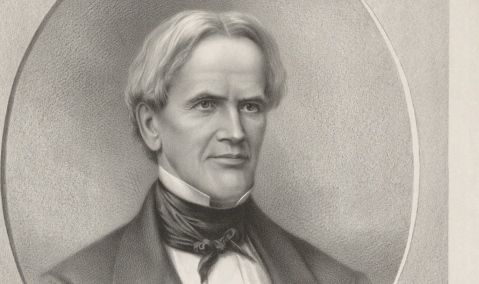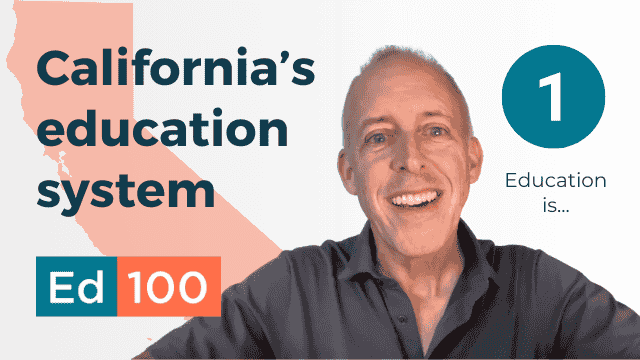
A brief history of public education
School should be free and mandatory for all kids. It's obvious, right?
Actually, it's kind of a new idea.
In This Lesson

What is a public school?
What is a Blaine Amendment?
What is the history of public schools?
How did we put children in schools 100 years ago?
When did school become mandatory in America?
What was the Keating-Owen Act?
When did the school lunch program start?
What is the Elementary and Secondary Education Act (ESEA)?
How did Sputnik affect education in America?
How did "A Nation at Risk" change education?
What was the standards movement?
What was No Child Left Behind?
What was Race to the Top?
How has COVID-19 changed education?
▶ Watch the video summary
★ Discussion Guide.
This lesson summarizes major milestones in the history of public education in the United States.
Large-scale public education in America began in Massachusetts in the 1850s under the leadership of Horace Mann (pictured above). Mann developed an organization of over a thousand schools modeled on the Prussian system of common schools.
Public education expanded further under President Ulysses S. Grant, who in 1875 campaigned for a constitutional amendment to mandate free public schools and prohibit public funding of religious schools. This amendment (known as the Blaine Amendment) failed, but the policy was adopted in most state constitutions. The idea that free public schools should be widely available and separate from religious institutions began to become part of the fabric of America.
Free public education and the end of child labor
Tuition-free basic education has been generally required in America for more than 100 years. It was a big transition. In 1910, more than a quarter of children in America did not attend school. At the time, even radicals in America viewed tuition-free universal education as a dream.
Tuition-free basic education has been universal in America for more than 100 years.
Putting children in school required first extracting them from fields and factories, where the poorest endured horrifying conditions with few protections. Around the turn of the 20th century, American journalists drew attention to the dreadful working conditions in factories. Women organized in protest, collaborating with the labor movement to press for policy changes.
By 1916 most states, following examples in Europe and Massachusetts, had passed laws to outlaw, discourage or at least regulate childhood labor. As states developed laws regarding child labor, they also changed public expectations about public schooling.
Milestones in the history of universal education
Over the last hundred years, a broad theme in the evolution of public education has been to make access to it more universal.
|
Milestones in the history of public education |
|
|---|---|
|
Create the idea of public schools |
In the 1850s, Horace Mann popularized the idea of public schools in America, inspired by schools in Prussia. |
|
Make school mandatory |
In 1910, a quarter of America’s children did not attend school. By 1918, Mississippi became the final state to pass laws mandating that public school should be not only universally available but required through elementary grades. |
|
Get kids out of the factories |
The Keating-Owen Act of 1916 set federal standards for the maximum number of hours children could work, and banned interstate trade in goods manufactured by children. This measure was overturned by the Supreme Court in 1918, but the trend had been firmly set. |
|
Feed kids so they can learn |
In 1946 Congress began funding for a nationwide school lunch program, creating a new reason for impoverished families to send their children to school and establishing an essential precedent for federal support for education. |
|
Include all races in schools |
In 1954, the Supreme Court ruled unanimously in Brown v. Kansas Board of Education that schools could not be segregated by race. |
|
Include schools in impoverished areas |
In 1965, President Lyndon B. Johnson signed the Elementary and Secondary Education Act (ESEA) as a key element of his War on Poverty. Title I of this Act provided federal funding to support education in low-income communities. |
|
Include girls in schools |
In 1972, Congress amended the Higher Education Act of 1965, adding Title IX to prohibit discrimination against students in federally funded schools on the basis of sex. (It’s pronounced “title nine.”) |
|
Include students with disabilities |
In 1975 the US Congress established that American schools must provide a free and appropriate education to students with disabilities. |
|
Make schools work online |
In 2020, the COVID-19 pandemic prompted school systems across the world to move online. There were gaps, but in California, for the first time virtually all students were provided with devices and network access for online learning. |
|
Incorporate A.I. |
In 2023, the release of ChatGPT kicked off the era of Artificial Intelligence in education. |
Since the 1970s, state and national education policies have increasingly reflected this principle of universal access, including a growing sense that students should have equal access to not just a school, but a good school. Students must also have equal opportunity to succeed at school: they are protected from discrimination in the classroom.
A century of steadily expanding and improving access to education has fundamentally changed America, both economically and socially. Universal public education is a major proof point for America's self-image: this is a land of opportunity for all.
Education is a strategy for national defense
National security concerns have strongly influenced the history of educational system throughout the world.

Sputnik
In the early years of the Cold War, the Soviet Union's launch of Sputnik sparked concern that America was falling behind, and failing to produce the scientists and inventors needed for a nuclear age. This sparked a wave of investment in science programs in America's schools and universities. Today it is widely accepted that education is connected not only to economic and military security, but social aims as well.
In 1983, a report titled A Nation at Risk called for sweeping changes in U.S. education, and kicked off a series of national conversations about standards. The goal was to improve what children know and are able to do at each grade level so the U.S. could stay safe and competitive in a global economy. A widespread consensus led to passage of the federal No Child Left Behind Act (NCLB) in 2001. The big-picture goal of NCLB was to gradually raise the achievement bar, year by year, so that all children, including those usually "left behind", would receive a solid education. The law required each state to establish grade-level standards and to test all students annually in order to evaluate each school’s success.
As the bar rose, many schools did not meet the expectations, especially for their students living in poverty. Popular support for the law collapsed. In 2015, a bipartisan consensus in Congress replaced NCLB with the Every Child Succeeds Act (ESSA), which kept the requirement for annual testing but significantly reduced the federal role in pressing for measurable improvement in test scores.
Education is a strategy for national inclusion
NCLB revealed that the 50 states expected widely different things from their students. Many states' standards had been written clumsily, with a narrow definition of success. In 2009, the National Governors Association initiated a project to make standards more meaningful and useful by defining a new set of shared standards that became known as the Common Core State Standards. (More about that in Lesson 6.1.)
These standards originated with the states, but federal funding was key to their adoption. The Obama administration used a competitive federal matching grant program called Race to the Top to challenge states to develop strong implementation plans. California set 2015 as the year it would begin evaluating the performance of its students and schools based on these new standards.
How the pandemic changed education
In 2020, the COVID-19 pandemic suddenly changed education for virtually all students in at least three ways. First, it evaporated the expectation that all children must always attend school in person. Second, it demonstrated that relationships matter for learning. Third, it further widened the educational gap between students of different backgrounds. When federal emergency funding ran out to subsidize connectivity and devices in lower-income school communities, digital divides quickly worsened.
During the pandemic, school districts scrambled to provide children with ways they could continue learning at home — especially with digital resources for distance learning. Their efforts were partially successful, but it quickly became clear that the internet had become the new #2 pencil — school just doesn't work without it.
Access to computing devices and high speed internet is unequal across socioeconomic classes. Online learning works pretty well for students who have experience with technology, access to tutors, and a quiet place to work. Rich kids have all that. Poor kids don't.
The lessons of the Pandemic for education will take years to be clearly understood, but it is already clear that it widened the educational gap between students of different backgrounds.
Education is a bipartisan issue
America has enjoyed a rough national consensus that education, along with national defense and social security, is vitally important and worth investing in. Maintaining this consensus is essential because universal public education costs serious money and requires serious taxes. As discussed in Lesson 1.1, most developed nations and states commit about 3% to 5% of their economy to public education through high school. California falls on the low-effort end of this spectrum, but 3% of the economy is a substantial commitment.
Why have lawmakers over time cared about education issues? Because their constituents care about them. Policymaking is hard. People disagree vehemently, and the path to wise policy is rarely clear. Lawmakers choose their point of view with expert advice from advocacy organizations and think tanks (Lesson 7.7), of course, but when parent leaders and student leaders present a clearly developed point of view they listen with attention.
What’s Ed100’s role in this scrum, you ask? We help members of parent organizations, school boards, and student organizations become well-informed constituents. With knowledge, they can develop their own point of view, empathize with other points of view, and prepare to have a voice in the room where it happens.
Reason for hope
People disagree about public education policies in a way that has become noisy and partisan. Disagreements simmer about charter school policies, for example, or the role of unions, or how much money to spend.
But it's worth noting how little we argue these days about the basic principle that all children should have the chance to attend quality schools and meet high academic standards. Horace Mann would be pleased.
Last updated June 2025
CHAPTER 1:
Education is…
-
Education is…
Overview of Chapter 1 -
California Education
Are California’s Schools Really Behind? -
American Education
Are U.S. Schools Behind the World? -
Education and the Economy
Schools for Knowledge Work -
Educational Failure
The High Social Costs of Bad Apples -
Grade Inflation
Wishful Thinking and Cognitive Bias -
Are Schools Improving?
Progress in Education -
History of Education
How have Schools Changed Over Time? -
Purpose of Education
What are Schools For, Really?
Related
-
Purpose of Education
What are Schools For, Really? -
Grade-Level Standards
What is the Common Core? -
STEM Education in California
Science, Technology, Engineering and Math -
Why Are Tests Important?
Why Tests Matter and How They Work -
Financial Literacy in California
Learning to Earn -
Should the Education System be Blown Up?
Would Disruption Help?
Sharing is caring!
Password Reset
Search all lesson and blog content here.
Login with Email
We will send your Login Link to your email
address. Click on the link and you will be
logged into Ed100. No more passwords to
remember!














Questions & Comments
To comment or reply, please sign in .
Sara Wolfe September 1, 2025 at 5:16 pm
Eliza Sauer January 29, 2020 at 7:00 am
Caryn January 30, 2020 at 9:23 am
Caryn January 30, 2020 at 9:26 am
francisco molina August 13, 2019 at 12:22 am
Jeff Camp July 4, 2018 at 11:46 am
Sonya Hendren September 6, 2018 at 2:32 am
Carol Kocivar July 14, 2016 at 8:39 pm
This report, requested by the Civil Rights Act of 1964, documents the availability of equal educational opportunities in public schools for minority students. http://files.eric.ed.gov/fulltext/ED012275.pdf
Education Week takes a look at then and now
http://www.edweek.org/ew/section/multimedia/50-years-seeking-educational-equality-the-coleman-report.html?cmp=eml-enl-eu-news1-RM
arienneadamcikova April 20, 2015 at 10:22 pm
Jeff Camp - Founder April 20, 2015 at 11:23 pm
Alice Griesemer March 23, 2015 at 5:49 am
What are we fighting about?
In 1850... All children should go to school.
In 1960... All children should go to a good school.
In 2000... All children should go to a good school and achieve at a standard level.
I wonder when we will be able to claim victory on the current debate and what the next one will be.
Veli Waller April 2, 2015 at 12:26 pm
Jeff Camp - Founder April 2, 2015 at 2:17 pm
anamendozasantiago February 11, 2015 at 5:24 pm
These students after years of neglect from our education system get so tired they begin looking elsewhere for challenges. It is a great loss for our society, state and country when we lose one of these talented minds to an educational system that is not meant to serve them.
"In the wake of sputnik, some educational programs were created to identify and support the education of children identified as the 'Best and Brightest.' These programs are mostly gone now."
Kim April 9, 2016 at 6:41 pm
celia4pta September 25, 2014 at 9:26 pm
RTTT did reward states for adopting internationally benchmarked standards, and CCSS were the easiest way to do this, but the initiative for the writing of the standards came from the National Governors Association.
Celia
Jeff Camp - Founder October 2, 2014 at 12:17 pm
--Jeff